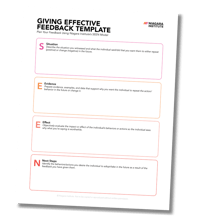6 min read
How To Give Feedback to Employees, Peers, and Bosses (+Template)
Whether you’re praising a peer for a job well done or guiding an employee on a project that’s faltering, feedback is how those around you learn and...
4 min read
 Michelle Bennett
:
Nov 7, 2023 2:14:00 PM
Michelle Bennett
:
Nov 7, 2023 2:14:00 PM
.png)
Many leaders have trepidations when it comes to delivering employee feedback. A survey of over 7,000 people uncovered that 44% of managers find providing employee feedback stressful and challenging, with 21% avoiding it altogether. Yet, feedback is essential to helping employees grow, making positive changes, and avoiding costly mistakes.
If you feel uncomfortable giving employee feedback, this quick guide for leaders will help. Within it, you’ll find information on employee feedback, why it is important, its purpose, and a few practical tools to help you be more confident in delivering it. Let’s jump in.
Jump to:
Giving employee feedback is when a leader assesses performance, gives constructive insights, and provides praise to direct reports. It’s an opportunity for open, two-way dialogue between an employee and their immediate supervisor where they can learn from each other, fine-tune their skills, celebrate wins, and work together on strategies for improvement.
When a leader engages in frequently giving feedback, it goes beyond just recognizing when something goes well or an area of improvement; it fosters an environment of growth, trust, and engagement.
.png?width=1000&height=563&name=Definition%20of%20Employee%20Feedback%20(1).png)
Why is Giving Feedback Important?
While you may dread giving feedback to employees, the fact is employees crave it. So much so that one Gallup survey found people would prefer to get any feedback over no feedback at all, even if that feedback is negative. They want to know where they can grow, what they’re doing well, and where they stand with you.
Yet, according to many studies, most leaders are not providing feedback at a frequency (or at all) that employees want and expect from their direct leader, which has implications on attracting and retaining employees, engagement, and corporate performance. Here are just a few facts that prove just that.
.png?width=1000&height=563&name=84%25%20of%20employees%20who%20are%20engaged%20at%20work%20strongly%20agree%20that%20they%20have%20received%20meaningful%20feedback%20in%20the%20last%20week.%20(1).png)
In the workplace, there are many reasons for giving frequent employee feedback. Here are six common purposes of employee feedback.
When employees fall into a repetitive and comfortable routine at work, it can cause their growth and development to become stagnant. But, as the saying goes, “You don’t grow when you’re comfortable.” So, if you want your employees to grow and reach their full potential, then giving feedback is crucial as it breaks the monotony of the job and challenges them to think outside the box or take a different approach than they would normally, thus contributing to their growth and development.
No one wants to repeat the same mistake over and over. But what if your team members don’t know they're making a mistake? As a leader, it’s up to you to give your employees feedback if they are repeatedly making mistakes. You want to make them aware of the mistake, communicate the consequences of it, and then collaborate on a solution to ensure the mistake doesn’t happen again. More often than not, this provides a sense of relief to both parties.
Providing feedback is an opportunity to help an employee see how their actions impacted a person or project, for better or worse. By identifying these blind spots, which they may have otherwise been unaware of, you encourage employees to become more self-aware of their actions, mindset, and behaviors.
It shouldn’t take an annual performance review for an employee to know where they stand with you regarding their performance. In fact, if you provide your employees with feedback regularly, they should know exactly where they stand on any given day of the year. That’s because employee feedback eliminates the guesswork and replaces it with clear, actionable insights.
Feedback conversations are an opportunity to ask questions, listen, and collaborate with an employee on an actionable solution. Employees crave these types of interactions with their leaders because when employees feel their voice is heard, they are 4.6 times more likely to perform their best at work. Conversely, it was found that 33% of employees said a lack of open, honest communication has the most negative impact on employee morale.
A Harvard Business Review survey found that while 58% of people trust strangers, only 42% trust their own boss. Delivering honest, actionable feedback is just one way to build trust among employees if you approach it with a genuine desire to help an employee and have their best interests at heart.
Employee Feedback Templates, Tools, and Articles for Leaders
Now that you’re equipped with the knowledge and appreciation for the importance of giving employee feedback, you’re likely to want to learn more about how to deliver it and have tools to help you along the way. Here are six templates, tools, and articles you may find useful.
 Giving Feedback Template: Feel better prepared and more confident giving feedback to employees with the feedback template. It's an editable PDF that will walk you through the four-step process of preparing to deliver good feedback.
Giving Feedback Template: Feel better prepared and more confident giving feedback to employees with the feedback template. It's an editable PDF that will walk you through the four-step process of preparing to deliver good feedback.
The FAQs of Managing Employee Performance: How do you evaluate employee performance? What are the most common performance issues? Find the answers to these questions and more in this article.
Everything You Need to Start Having Coaching Conversations: Having coaching conversations at work with employees is critical to their development. Get everything you need to start coaching your direct reports here.

Toolkit for Effective Performance Management: Get tips, templates, and processes to develop your people, achieve team goals, and drive high performance.
10 Things Not To Do When Giving Feeback: When you give feedback, it can go sideways quickly when not done well. In this article, we explore ten pitfalls to avoid when providing feedback.
How To Address Poor Performance: In this article, learn the general steps leaders should take to address and discuss poor performance with employees in the workplace.
%20(1).png)
6 min read
Whether you’re praising a peer for a job well done or guiding an employee on a project that’s faltering, feedback is how those around you learn and...
%20(1).png)
4 min read
How am I doing at work? Where can I improve? Employees desperately want to know where they stand with their direct supervisor, but unfortunately for...

8 min read
When you’re at work, do you want to know where you stand with your boss, peers, or clients? Do you want to see whether you’re doing a good job, and...